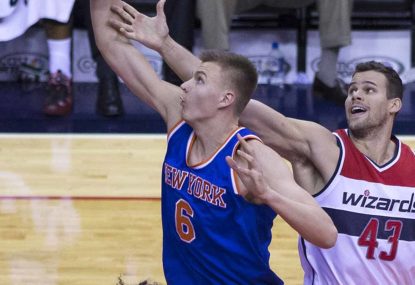LISTEN: Journalist under fire for 'gross... creepy' interaction with Caitlin Clark
https://twitter.com/KatieMox/status/1780695947481174464 https://twitter.com/CWilliamson44/status/1780696642917994703

Moses Malone, Roy Tarpley, Anthony Mason, Jerome Kersey, Jack Haley, Christian Welp, Darryl Dawkins, Dave Meyers, Hot Rod Williams. All of the aforementioned were former NBA players who died in 2015, all taken far too soon.
All were in their 50s and 60s, except for Mason, who didn’t even make it to 50, suffering a massive heart attack in February last year and passing away at just 48.
In a majority of the deaths, heart-related ailments were listed as the cause.
Is it any wonder Larry Bird doesn’t think he’ll live much longer?
“I tell my wife all the time, ‘You don’t see many seven-footers walking around at the age of 75’. She hates it when I say that,” he said last week.
“I know there are a few of us who live a long time, but most of us big guys don’t seem to last too long. I’m not lying awake at night thinking about it. If it goes, it goes.”
Bird, who is 6’9″, was talking to ESPN’s Jackie MacMullan, understandably pondering his own mortality as so many former protagonists were falling around him.
The 59-year-old three-time Most Valuable Player has his own heart issues, suffering for years from atrial fibrillation, where an abnormal heart rhythm causes palpitations, shortness of breath and chest pain. It also increases the risk of stroke, heart failure and dementia.
It’s a particularly cruel double blow for ex-NBA athletes; not only is atrial fibrillation a condition more likely to appear in older men, a 2006 study showed merely being tall is also an independent risk factor in contracting the disorder.
“Patients in the tallest quartile group had an atrial fibrillation prevalence that was 32 per cent higher than those in the shortest quartile,” the study states.
“Extrapolating from this result indicates that every 16 centimetres (about six inches) increase in height is associated with a 50 per cent increase in the chance of developing atrial fibrillation.”
So NBA players, who are, for the most part, well above six feet tall (the average player height in the league these days is 6’7″), are automatically at risk and have no way of adjusting said risk.
Put simply, they can’t make themselves shorter.
And, as noted by both MacMullan and in David Epstein’s The Sports Gene, American males who are seven-foot or taller are so rare that an astounding 17 per cent of them will at some point play in the NBA.
Even someone like the NBA’s all-time leading scorer Kareem Abdul-Jabbar – who was a paradigm of health during his career and after it – has had to have quadruple coronary bypass surgery in the past year. And that after fighting chronic myeloid leukemia, a rare form of blood cancer, just six years prior.
While not as obvious a link as the NFL’s insidious issues with concussions, chronic traumatic encephalopathy (CTE) and the spate of post-career deaths among retired footballers, one wonders how much strain ex-NBA players put on their oversized bodies and what the ultimate price – ie: a drastically reduced life expectancy – might be.
We all remember the NBA players who were taken in the prime of their careers – Reggie Lewis to name an obvious example, Jason Collier and Conrad McRae two lesser known but no less tragic instances. But what about the ex-players, whose public presence has largely faded to less than a whisper?
Cancer and related illnesses have claimed the likes of Hot Rod Williams while Jerome Kersey, who was a much-loved figure in Portland, died suddenly of a pulmonary thromboembolism believed to be related to a recent knee surgery.
And for those lost to darker circumstances such as murder – think Bison Dele and Lorenzen Wright – or suicide – Ricky Berry, Mel Turpin and Bill Robinzine for example – there is even less mention.
And it’s not like heart issues in NBA athletes is a recent phenomenon, witness Pete Maravich’s tragic death at just 40 years old, playing pickup ball at a church in Pasadena in 1988. Or Wilt Chamberlain, who battled his own irregular heartbeat ailments for years before succumbing in October 1999 at just 63.
Wilt, the Big Dipper, once lamented that “everybody pulls for David, nobody roots for Goliath”.
Thankfully, that no longer appears to be the case.
The NBA Players’ Association has combined with the NBA to offer medical screenings for retired players, part of a direct response to the deaths of Dawkins and Malone.
The passing of Malone, in particular, was a warning klaxon for his fellow retired cohorts.
A fitness nut during his playing days, the 6’10” Malone outworked his bigger opponents through sheer effort, honing his stamina with home workouts on a Nautilus machine and legendary off-season playing sessions at The Fonde Recreation Centre in Houston.
No-one had tried to keep themselves in better post-career shape than Big Mo, save for someone like David Robinson, who still has a 33-inch waist despite not having played in the NBA for well over a decade now.
Clearly, ‘The Admiral’ is either a 7’1″ genetic freak or an interstellar alien. The jury’s still out on that one.
But flippancy aside, it’s encouraging to see the powers-that-be taking a legitimate interest and concern in the well-being of former players.
In 1991 everyone considered Magic Johnson’s HIV announcement to be an automatic death sentence, yet medical science has allowed the legendary Laker almost an extra quarter-century (and much more, hopefully).
If nothing else, raising awareness of what has been a far bigger shadow over professional basketballers will result in similar advancements for former, current and future NBA players.